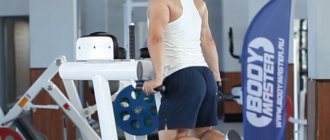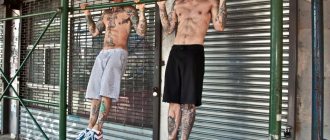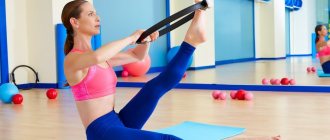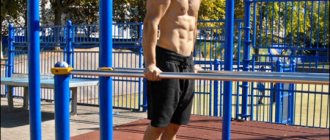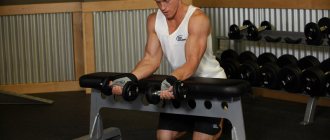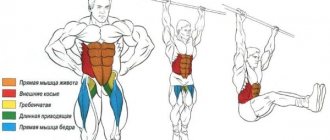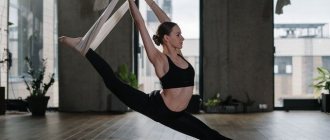Exercises on the uneven bars are included in the training program by both professional and amateur athletes. This sports equipment is very popular among athletes for a reason. Regular exercises help pump up: deltoids of the shoulder girdle and triceps, which are quite difficult to give relief with the help of other types of strength training.
This simulator, familiar to everyone since childhood, allows you to achieve impressive results. It should be understood that it will not be easy for an unprepared person to practice it. When including exercises in your training regimen for the first time, carefully monitor your condition. Avoid overloading to avoid tearing your muscles. Otherwise, you will have to take a long break to fully recover.
What muscles work when exercising on parallel bars?
The uniqueness and high effectiveness of strength exercises on the uneven bars lies in the fact that the athlete can independently change the target muscle group by adjusting the execution technique.
Depending on the technique chosen, the athlete can work the triceps or pectoral muscles. In addition, the back and synergistic muscles are actively involved in the work - muscles that are involved in the work together with the main muscle group being trained.
It is noteworthy that the triceps experience stress in any case, regardless of how you do push-ups. Just to a greater or lesser extent. The chest muscles, at the same time, always take on part of the work. That is, in order to work a specific muscle group, it is necessary to perform movements in strict accordance with a specific technique.
So, while practicing on the uneven bars, you can train:
- triceps;
- pectoralis major muscles;
- anterior deltoid;
- ligaments of the elbow, wrist and shoulder joints;
- back muscles;
- rectus, transverse, external and internal abdominal muscles (abs);
- When bending your legs back, the buttocks and biceps of the thigh are included in the work.
Working muscles
Bars are used for different types of movements and this determines which muscles are pumped during their execution.
We list the main ones:
- Push-ups work the chest, shoulders and triceps
Indirect load falls on the forearms, lats, abs and small stabilizer muscles of the torso.
- Australian or horizontal pull-ups activate the lats, biceps and forearms
The trapezius (back, back), shoulders and abs are indirectly loaded.
- Leg raises engage the rectus abdominis, while lateral raises focus on the obliques.
In static mode, the forearms, triceps and shoulders work.
In fact, with the help of different movements on one apparatus, the main muscle groups of the upper body are pumped - chest, shoulders, triceps. As well as biceps, lats, trapezius and abs.
How to properly train on parallel bars
Bars, like any other sports equipment, require compliance with certain rules. These settings are not particularly complicated, but it is necessary to adhere to them so as not to harm yourself during training.
- All movements during the parallel bars exercise program should be smooth. When doing push-ups, you should lower yourself down carefully, avoiding jerking. When working your abdominal muscles, you also need to act carefully, smoothly lowering and raising your legs.
- Don't forget that sudden, inept movements are the most common cause of injury.
- For push-ups, it is best to use parallel or angular machines. The second option is more versatile, as it allows you to adjust the grip width.
- When pumping your chest muscles, do not spread your elbows too wide. An angle of 45 degrees is considered optimal.
- When making a downward movement, do not go down too deep. The stretch should be noticeable, but not excessive. Many novice athletes try to extend their arms as much as possible, which often leads to damage and inflammation of the joints.
Execution Rules
Before you start practicing on the uneven bars, be sure to warm up your muscles well, this will reduce the risk of injury. Perform the exercise slowly, controlling and stabilizing your body through your core muscles. Don't move your head, legs or swing your body in an attempt to help yourself pull yourself up.
Push-ups should be started from the top point. The body weight must be transferred to the arms. Your back should be straight and your shoulders should be pulled back. You need to lower yourself very slowly, leaning your body forward and maintaining tension in your muscles. Then you can fixate for a short time at the lowest point. The angle at the elbow should be maintained within 90 degrees. You need to rise just as smoothly and under control. Particular attention should be paid to breathing: inhale when lowering, and exhale when ascending.
Varieties of exercises on parallel bars
There are not many exercises that can be performed using parallel bars. Moreover, most of them are aimed at working the muscles of the chest and triceps. Push-ups are especially common, they are among the basic ones and are the most effective.
Universal push-ups
Take the starting position on the apparatus with straightened arms. In the upper position, try not to bend over, keep your legs crossed or simply connect them together.
As you inhale, gently bend your elbows and gently lower yourself down as far as possible. Ideally, your hands should be at the same level as your armpits. In the lower position, hold for 2-3 seconds and, as you exhale, “throw” your body up, again rising to straight arms. When performing the movement, try not to sway or move your legs back.
Push-ups for training the pectoral muscles
To set the load on the chest muscles, it is necessary to select a projectile with a wider distance between the bars. The more the shoulders are pulled away from the body, the more the pectoral muscles are involved in the work.
Jump onto the apparatus, take the starting position with straight arms. Exhaling, slowly lower yourself down. About halfway through the movement, spread your elbows to the sides, and almost at the bottom point, bend forward. As you exhale, return to the starting position, lifting your body by contracting your pectoral muscles.
Push-ups with emphasis on triceps
This is an ideal parallel bars exercise for beginners as it is technically easier to perform. Triceps push-ups are more natural for beginner athletes with poorly developed neuromuscular connections.
Unlike the previous option, to perform it you have to select a projectile with a small distance between the crossbars. There is no need to spread your elbows; on the contrary, press them close to your body. At the same time, keep your body perpendicular to the floor surface/ground (do not lean forward).
When descending, do not try to reach the lowest possible point. It is enough to bend your elbow joints to a right angle. When taking the top position, do not straighten your elbows completely. Otherwise, the main load will not be on the triceps, but on the joints and ligaments. Which in itself is very traumatic, especially when working with weights.
Pronated grip push-ups
This exercise is performed in the same way as triceps push-ups. There is no need to go down too deep and lean forward. The main difference is that when placing your palms on the apparatus, you should turn them away from you (the effect of inverted hands). This position allows you to achieve maximum load on the triceps.
Horizontal push-ups (lying on parallel bars)
This movement is very similar to regular push-ups. Only in this option will it be possible to lower the chest below the level of the palms, which will allow you to place a greater load on the triceps and pectoral muscles.
You have to do push-ups “lying” on the apparatus, resting your toes on the bars. Take the starting position, press your elbows to your body. As you inhale, slowly lower yourself down, trying to keep your chest below the level of your palms. Exhaling, return to the starting position.
Walking on your hands
The essence of this exercise is to take the upper position on the apparatus and move along the entire length, moving your hands. Accordingly, for execution it is necessary to select bars of the appropriate size. Depending on the width of the “step”, the depth of flexion of the elbow joints and the tilt of the body, various muscle groups are worked out. But no matter how you walk, in any case the muscles of the shoulder girdle, back, and forearms will be subject to stress.
Abdominal muscle training
When performing any type of push-ups, the athlete's body remains almost static. All dynamics are focused on the work of the arms and shoulder girdle. But, in order to pump up the abs with the help of parallel bars, you have to use the lower part of the body, leaving the upper limbs motionless. Among the common schemes for training the abdominal muscles:
- Straight leg raise. Allows you to work out the muscles of the lower abs.
Take the top position on the apparatus. Keep your back straight, do not lean forward. Stretch your legs and bring them together. Now slowly raise them to the level of the crossbars and also slowly lower them. When performing this exercise, try to exclude any other movements.
- Raising bent legs. The lower abdominal muscles are also involved here, but the back and hips are also involved in the work.
A simplified version of the previous exercise. While in the starting (top) position, bend your knees and pull your legs as close to your body as possible.
Interesting facts and observations
Multiple Olympia champion Jay Cutler came up with a special version of the exercise in which the triceps are used to the fullest. He works in V-shaped bars with his back to the apparatus. This allows even with a wide back and massive arms. Cutler recommends partial repetitions for this exercise, especially if the lifter is lifting a significant amount of weight. He considers the full amplitude to be traumatic.
Parallel bars training program
To work out all muscle groups, you need to choose the optimal training regimen for yourself. So, for example, you can use the following training scheme:
- Warm up - 5 minutes.
- Bent leg raises - 10 reps.
- Push-ups on the chest - 12-15 times.
- Universal press - 10-12 repetitions.
- Triceps push-ups - 10-12 reps.
- Pronated grip - 8-10 times.
- Horizontal press - 10-12 repetitions.
- Straight leg raises - 8 reps.
- Walking on parallel bars - all the way.
- Hitch.
Depending on your physical fitness, you can do 1-3 approaches. It is recommended to rest no more than 1 minute between sets. For greater effectiveness, sports trainers advise alternating exercises on parallel bars and horizontal bars.
Recommendations for training
Bars are a fairly simple sports equipment, but any exercise on it requires compliance with certain rules. They will help achieve the fastest possible progress in muscle development and reduce the risk of injury to zero.
Warm up before class
Before performing exercises, be sure to do a light warm-up. This is especially true for push-ups and pull-ups. These movements put a lot of stress on the fragile shoulder and elbow joints and ligaments.
Attempts to exercise on unheated muscles, as a rule, end in an unpleasant injury.
So don't skip the warm-up. It is your guarantee of athletic longevity and rapid muscle growth.
Perform several swinging or rotating movements for each muscle group. Also add some light dynamic stretching without too much pressure. The whole process takes from 5 to 10 minutes .
Load change
Muscles adapt very quickly to strength training. They get used to the same type of load in just 2-3 weeks, and this leads to a significant slowdown, and then to a complete stop of progress.
To prevent this type of addiction, regularly challenge yourself . This is done in different ways:
- increasing the number of exercises per muscle, approaches and repetitions
- weight gain
- reducing rest pauses between approaches, etc.
Another way to vary the load when doing dips is using loop fitness bands. For example, expanders or elastic bands.
If the tourniquet is secured to the handles so that the middle of the rubber hangs down, you can place straight legs or knees on it (depending on the length of the rubber), making it easier to perform. The rubber will help push your torso up.
This option is suitable for beginners with a low level of physical fitness or for beginner girls.
If you fasten the edges of the tourniquet to the handles, or another stop at the bottom, and throw the middle over your shoulders, you will have the opposite effect.
In the bottom position, the movement is performed as usual. But the higher the body rises, the more resistance will have to be overcome due to the tension of the rubber. And the more muscle effort you will have to apply.
This method is suitable for well-trained men for whom regular dips become too easy.
Rest between sets and workouts
Depending on your goals, rest between sets and workouts will differ.
When exercising to increase muscle mass and strength, do it no more than 2 times a week.
Remember that muscles grow during the rest period between workouts. And if the load is too frequent, they will not have time to recover, and therefore increase their volume.
Mass training involves the use of heavy and medium additional weights. Therefore, during this period, rest pauses are 2-3 minutes.
If you are a beginner athlete, progress in muscle growth will come from minor loads. At first, they hone the movement technique. Only when the athlete performs 15 or more push-ups without much effort is additional weight used.
When training on relief, exercises on the uneven bars are performed up to 3 times a week.
Here they mainly use their own body weight, without additional weights. Therefore, they try to reduce the pauses between approaches to a minimum (30-60 seconds).
When training for strength endurance, flexibility and coordination, train exclusively with your own weight. The frequency of classes for amateurs is 4-6 times a week.
Depending on the type of motor quality being developed, rest pauses range from 30 to 120 seconds.
About the role of technology
Like any other exercise, we try to do all movements on the uneven bars as correctly as possible, observing all the technical requirements for a specific exercise.
Only with the correct technique will you work the target muscles as much as possible and get the desired result in a minimum period of time without injury.
Common Mistakes
Many beginners and even experienced athletes make mistakes during training. The most typical of them should be listed:
- Some athletes spoil the effect of training by taking the wrong starting position (excessively wide grip). As a result, the load on the deltas increases greatly, which can ultimately lead to injury.
- Failure to comply with breathing rules during training. The downward movement should be done while inhaling, the lifting should be done while exhaling.
- Execution too fast. When including dips in your program, forget about speed and sudden jerks. Your actions should be smooth.
- Excessive use of additional burdens and untimely implementation. Don't use too much weight. Add it gradually, only when you can complete 3 sets of 20 repetitions with the current one.
For newbies
Most women, as well as beginner athletes, have insufficiently developed chest, arm and back muscles. As a result, the parallel bars press will not be performed fully. Accordingly, many people have a question: how to learn to do push-ups on uneven bars from scratch? We suggest using the following recommendations:
- Start training in the gravitron. This machine makes it much easier to perform exercises due to its counterweight.
- Strengthen your muscles with other exercises. Perform various types of push-ups, bench presses, and bench presses.
- In the initial stages, try doing push-ups using partial amplitude, increasing over time and bringing it closer to the normal position.
- To establish good technique and practice correctly in the future, use the help of a trainer.
- First, learn how to do negative push-ups. In them, the main emphasis is on the slow descent of the body, rather than on the rise. By exercising in the negative phase, you can increase the effectiveness of your training and develop muscle strength.
Tips for beginners
- Don't round your back. Even when leaning forward, it should remain straight.
- Do not bend your wrist and elbow joints.
- The width of the apparatus should be matched to the width of the athlete’s shoulders.
- Do not jump off the apparatus on straight legs, but carefully descend from it so as not to injure your spine.
- Do not use unstable or broken equipment for training.
- Be sure to warm up before performing the main program.
- Supplement your exercise with proper nutrition to achieve better results.
- Carefully follow all stages of the exercise. Don't stay too long in the bottom or top position.
- Make sure that your movements are measured, without jerking or haste.
Relief development
Not all athletes set themselves the goal of increasing muscle mass. For many, endurance and drawing are more important.
The parallel bars training program for relief involves a large number of repetitions with your own weight.
The nature of training in this case will be determined by the specific goal of the athlete.
If you need to dry out in general, reduce the subcutaneous fat layer as much as possible so that the muscle relief becomes clearly visible, then the entire training process will be built on an aerobic principle.
You sweat, you feel an overload of the respiratory system - it means you are doing everything right, the excess weight is gone.
Exercises on parallel bars are very energy-intensive by default, so they are perfect for this purpose.
The main thing is not to cross the fine line, from which, along with getting rid of fat, the body begins to burn muscles.
To avoid this, just follow the following recommendations:
- Let the body rest, all the main processes occur during sleep, as a response to the work done during the waking period;
- Take cortisol blockers, the so-called “stress hormone” that destroys muscles, for example, ascorbic acid is available and safe;
- Do not consume fast carbohydrates (sugar) before training; the body will not begin to use fat as energy while the blood is saturated with glycogen;
- Avoid alcohol, nicotine and junk food.
But sometimes it happens that there are no problems with excess weight, and the athlete is simply dissatisfied with individual muscles and even bundles of muscles.
In this case, isolation training will be useful. All muscle groups listed in the article can be improved to overall body condition in a targeted way.
One cannot ignore the so-called plyometric exercises, on the basis of which the increasingly popular CrossFit culture is based.
Their essence lies in the fast and explosive execution of repetitions, when at the end point of the amplitude the body hangs in the air for a moment.
Dilute your weekly parallel bars training program with plyometrics, and your efficiency will increase significantly, your circulatory system and heart will be strengthened.
Read also
- How to pump up your arms at home - training your arms at home
- Exercises with an elastic band for the back are the most effective exercises for a healthy spine and lower back.
- Back exercises at home. 8 most effective
- Posture exercises – a set of exercises for a healthy back
- Triceps exercises with dumbbells
Common mistakes when doing the exercise
Of course, at first glance it may seem that the exercises are quite simple, and it is simply impossible to make a mistake. However, dips can both benefit the body if the technique is used correctly, and cause harm if mistakes are made.
The most common errors are related to the position of the back and elbows or the inertia of the body.
But there are still other errors when working with a projectile:
- Breathing technique. Before lowering your body down, you need to take a breath, otherwise you can injure your chest muscles.
- Incorrect grip – wide or with a bent wrist. The most optimal is considered to be an average grip of hands at a distance of shoulder width.
- High speed push-ups. Sudden intermittent movements can harm the muscles. The delay for each lowering and raising should be 2 seconds. You need to keep the tension at the lowest point.
- Sudden weight gain. You need to add load gradually so as not to stress both the muscular and cardiovascular systems. The body must gradually, getting used to the load, strengthen its ability to build and strengthen muscle mass.
- Poor warm-up. How well you perform push-ups on the uneven bars depends on how conscientiously the warm-up is done. Poor warm-up often causes injuries. The warm-up can include stretching, push-ups and rotational movements of the joints.

